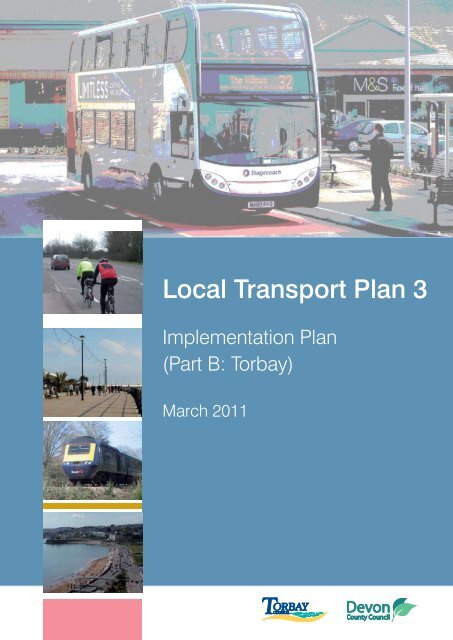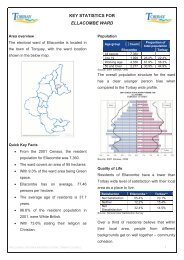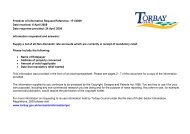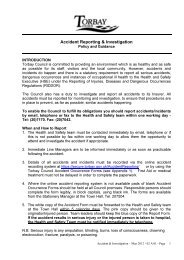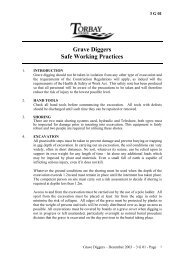LTP3 Torbay Implementation Plan - Torbay Council
LTP3 Torbay Implementation Plan - Torbay Council
LTP3 Torbay Implementation Plan - Torbay Council
- No tags were found...
You also want an ePaper? Increase the reach of your titles
YUMPU automatically turns print PDFs into web optimized ePapers that Google loves.
This document can be made available in other formats. For furtherinformation please contact 01803 208823.1133/0311
Devon and <strong>Torbay</strong> Local Transport <strong>Plan</strong> - <strong>Implementation</strong> <strong>Plan</strong> 2011ContentsSECTION A: TORBAY & DEVON IMPLEMENTATION OVERVIEW1. Introduction................................................................................. 71.1. Role of the <strong>Implementation</strong> <strong>Plan</strong>2. Funding Context ......................................................................... 72.2. Capital - Major Schemes2.3. Capital - Smaller Schemes2.4. Capital - Maintenance3. Devon-wide Schemes with <strong>Torbay</strong> ........................................... 103.2. Smartcards3.3. Bus Real-Time Information3.4. Devon MetroSECTION B: TORBAY IMPLEMENTATION PLAN4. Introduction............................................................................... 155. Funding detail ........................................................................... 155.1. Scheme Priority and Funding Allocation5.2. Highway Maintenance5.3. Exceptional Maintenance Scheme Prioritisation6. Scheme delivery programme ................................................... 197. Scheme delivery information.................................................... 237.1. Introduction7.2. Walking and Public Rights of Way7.3. Cycling7.4. Public Bus Services7.5. Bus Priority7.6. Park & Ride3
Devon and <strong>Torbay</strong> Local Transport <strong>Plan</strong> - <strong>Implementation</strong> <strong>Plan</strong> 20117.7. Parking Enforcement7.8. Real-Time Information7.9. Smart Cards7.10. Rail & Bus Integration7.11. Improving Rail Services7.12. Improve Existing Rail Stations7.13. Edginswell Station7.14. Transport Action Zones7.15. Highways Infrastructure7.16. Road Safety7.17. Western Corridor Improvements7.18. Hele Village Traffic Improvements7.19. Windy Corner Junction Improvements7.20. A385 West of Paignton Improvements7.21. Fleet Street Redevelopment7.22. Paignton Town Centre Improvements7.23. Minor Congestion Relief schemes7.24. Infrastructure for the Disabled7.25. Coach Parking Bays7.26. Ferry Services7.27. Travel <strong>Plan</strong>ning7.28. Alternative Fuels & Electric Car Charging Points8. Monitoring the delivery........................................................ 418.1. Introduction to monitoring8.2. Enabling Economic Growth and Development8.3. Enhancing <strong>Torbay</strong>’s built and natural environment8.4. Improve safety and activity levels8.5. Improve access to education, employment and services8.6. Making the big connections9. Summary.............................................................................. 50
Section A<strong>Torbay</strong> and Devon<strong>Implementation</strong>Overview
Devon and <strong>Torbay</strong> Local Transport <strong>Plan</strong> - <strong>Implementation</strong> <strong>Plan</strong> 20112012. If successful, construction would start on the scheme in summer 2012, with completiondue in 2015. Devon and <strong>Torbay</strong> will be required to fund a substantial proportion of the costsfrom local sources in addition to the Government funding.2.2.3. Not all major transport schemes in the area over £5m are funded directly by the Governmentthrough the major scheme bidding process. Some are delivered through local sources offunding including council corporate capital funding and developer contributions.2.3. Capital - Smaller Schemes2.3.1. Devon and <strong>Torbay</strong> have, in recent years, been successful in winning funding from varioussources, many of which were specific funds set up by the Government for different purposes.These include Community Infrastructure Fund (CIF) awards for schemes in Exeter and NewtonAbbot, the Big Lottery / Sustrans Connect 2 project in Newton Abbot, Living Streets in <strong>Torbay</strong>with the support of Sustrans, and the Cycle Exeter project from Cycle England. These were inaddition to the basic core funding from the Government known as the ‘Integrated Block’. Moredetail can be found in Table 2 below.2.3.2. The Government announced its spending plans for the next four years in October 2010. It isnot possible to accurately predict what the spending plans for a future Government will bebeyond the election in 2015. They may increase or decrease subject to many factors includingits priorities at the time and the state of the economy. Basic levels of funding for new transportschemes (the ‘Integrated Block’) for Devon and <strong>Torbay</strong> in the next four years are expected tofall by almost half compared to the last four – see Figure 1 below. This will be the same for allauthorities across England.Integrated Block£1,400,000£1,200,000£1,000,000£800,000£600,000Integrated Block£400,000£200,000£2010/11 2011/12 2012/13 2013/14 2015/16Figure 1: Indicative Integrated Block Capital Funding for Transport Schemes in <strong>Torbay</strong>2010/11 to 2014/15** Excludes South Devon Link Road major scheme. Confirmed funding levels are subject toapproval by Department for Transport8
Devon and <strong>Torbay</strong> Local Transport <strong>Plan</strong> - <strong>Implementation</strong> <strong>Plan</strong> 20113. Devon-wide Schemes with <strong>Torbay</strong>3.1.1. There are a number of schemes that provide benefits across Devon and that are expected to beimplemented jointly with <strong>Torbay</strong>, and in some cases, Plymouth.3.2. Smartcards3.2.1. Smartcards are a new form of payment for bus travel thatreduces passenger boarding times and improves theconvenience of bus travel for existing and potential users.They offer the potential for better value bus travel by openingup opportunities for more flexible ticket options that moreaccurately reflect users needs, for example the bulk purchaseof travel over a period which is not based on travellingevery day in the week. The benefits have been demonstrated bythe Oyster card scheme in London and supported by respondents to the recent Future ofTransport in Exeter consultation.3.2.2. There is potential to expand the role of smartcards to benefit everyone in Devon and <strong>Torbay</strong>. Inthe longer term the one card could pay for on and off-street car parking as well as bus travel.There may be future opportunities to expand this to cover other local authority services such aslibraries and sports centres, helping to reduce the number of different cards required.3.2.3. Funding will be considered in the first five-year period, subject to a full business case, tosupport the costs of introducing the equipment required to use smartcards. This will be from acombination of funding sources including a bid for regional funding. The scheme will need tobe delivered in partnership with bus operators and this will determine the timescale within whichthe project can be implemented.3.3. Bus Real-Time Information3.3.1. Real time information for buses is a key part of a 21st century public transport system forDevon and <strong>Torbay</strong>. Existing and potential users expect to be able to manage their journeyplans with up to date knowledge with information on disruptions and changes to servicesbeing particularly important. Rail users now make extensive use of the up to date informationavailable on a minute-by-minute basis. A real time system for buses has been in place inExeter for several years. There is now a need to expand the availability of real time informationto the whole of Devon and <strong>Torbay</strong> and further improve the system in Exeter. The benefits areparticularly significant for users in rural areas where services are less frequent, and a delay orcancellation of a service can cause major inconvenience to users without the knowledge tomake alternative arrangements.3.3.2. Real time information does not just benefit bus users. It is also an important tool to enable busoperators, particularly those with busy urban routes. The information provided enables theoperators to know exactly where vehicles are drivers are and reschedule them in response todelays or congestion if required. The information can also be used to provide bus priority attraffic signals when services are running late. This is particularly important where there is little orno scope for segregated bus lanes.3.3.3. A full business case will be developed to confirm the scope of the scheme. Delivery will requirea partnership with bus operators. Devon, <strong>Torbay</strong> and Plymouth will work together to providea comprehensive system across the three areas. Information displays will be provided at keylocations such as rail stations, certain bus stops, hospitals and major employers. Mobile andinternet technology will play a major role in getting information to users wherever they are.10
Devon and <strong>Torbay</strong> Local Transport <strong>Plan</strong> - <strong>Implementation</strong> <strong>Plan</strong> 20113.4. Devon Metro3.4.1. Devon Metro is an extensive plan to expand therole of railways serving Exeter and <strong>Torbay</strong> overthe next fifteen years. Exeter is almost uniquefor its size in having eight railway stations withinthe city with four suburban lines feeding into it.The feedback from consultation indicates thatrail has a major role to play in getting peopleinto Exeter and <strong>Torbay</strong>, across Exeter itself andconnecting with the national rail network for therest of the UK. This is supported by data in theEvidence Base that shows significant increasesin passenger numbers in recent years.3.4.2. The Devon Metro concept brings together the network of lines feeding into Exeter fromBarnstaple / Crediton and Okehampton (subject to confirmation of service provision), <strong>Torbay</strong>/ Newton Abbot / Teignmouth / Dawlish, Exmouth and Honiton / Axminster. The key strengthof the network is the ability to connect journeys across the city, for example from the <strong>Torbay</strong>line through to Digby and Sowton, serving the major employment location there. There is alsogrowing demand to locations such as Barnstaple and <strong>Torbay</strong> for leisure and tourism as well asbusiness needs.3.4.3. There are two key elements to Devon Metro: additional stations at strategic locations to serveemployment or housing growth and enhanced service levels and quality of rolling stock. Theproposed additional stations within the fifteen year period of the plan are at Marsh Barton,Newcourt, Cranbrook and Edginswell (<strong>Torbay</strong>). A new station serving proposed growth east ofOkehampton is anticipated in conjunction with the proposed new service by Dartmoor Railwaybetween the town and Exeter. Longer term new stations will be considered for other locationsincluding Monkerton (for Exeter Business Park and the planned growth in that location),Exmouth North and Cullompton. Monkerton and Exmouth North would require significantinvestment in additional track capacity on the Exmouth line.3.4.4. Both the Greater Western and South Western franchises are due for renewal in the next fewyears. The Government has indicated that it expects to award longer franchise periods that willprovide operators with greater flexibility of service provision. This will provide an opportunity forDevon to explore improvements to service patterns in conjunction with potential bidders. TheGreat Western Route Utilisation Strategy 1 produced by Network Rail supports the principle ofincreasing the service frequency on the <strong>Torbay</strong> – Exeter line to half hourly from 2016.3.4.5. Design work on Cranbrook station has been accelerated to enable the development of thenew settlement to progress. Construction is expected to start in 2012/13. The new station atOkehampton East is expected to be constructed in 2012 if the application by Dartmoor Railwayto run services is successful. The station will be funded by Devon County <strong>Council</strong>.3.4.6. Consultation on the overall Devon Metro concept was carried out through the Future ofTransport in Exeter consultation in spring 2010 and received strong support. Rail was also apopular suggestion for further improvements in the wider <strong>LTP3</strong> consultation. A full businesscase is being developed to justify the infrastructure investment from a number of sourcesincluding developer contributions and the Integrated Block. Additional track capacity atCranbrook will be a significant cost and require a separate business case. Construction, ifjustified, may take place beyond the fifteen year period of the plan.1www.networkrail.co.uk/aspx/4449.aspx 11
Section B<strong>Torbay</strong><strong>Implementation</strong><strong>Plan</strong>
Devon and <strong>Torbay</strong> Local Transport <strong>Plan</strong> - <strong>Implementation</strong> <strong>Plan</strong> 20114. Introduction4.1.1. The <strong>Torbay</strong> <strong>Implementation</strong> <strong>Plan</strong> sets out thetransport schemes <strong>Torbay</strong> <strong>Council</strong> proposesto deliver in the area, in order to realise thestrategy. These projects have been split intothree five year plans, explained later in thissection.4.1.2. This chapter examines the levels of fundingthat <strong>Torbay</strong> <strong>Council</strong> expects it will receivefor transport in the short term (first five yearplan) and how much of this finance will beallocated to each scheme. Due to limitedfunds, schemes have been prioritised forfunding based on deliverability, affordabilityand how they meet our goals set in theStrategy, having been widely consulted onacross <strong>Torbay</strong> and Devon.4.1.3. Detailed information on what the delivery of each identified scheme will actually mean in realterms for the residents of <strong>Torbay</strong> is included in this part of the document. The <strong>Plan</strong> also sets outthe monitoring framework for <strong>Torbay</strong>, in order to scrutinise the outcomes achieved in transportterms. A series of indicators to measure how <strong>Torbay</strong> meet the National Goals, as well asdelivering local aims and objectives as set out in the Place Strategy chapter of this document.5. Funding Detail5.1. Scheme Priority and Funding Allocation5.1.1. Schemes have been identified that are most important to achieve <strong>Torbay</strong>’s objectives andbroken down into foundation schemes and targeted capital interventions. These two typesof scheme are then split into three five year time periods. It is clear though, that there is anongoing need to make the best use of existing infrastructure and alternative sources of fundingwill need to be identified throughout the life of this <strong>Plan</strong>.Figure 3: <strong>Implementation</strong> <strong>Plan</strong> Five Year time framesShort Term Medium Term Long Term2011/12 - 2015/16 2016/17 - 2020/21 2021/22 - 2025/265.1.2. Some schemes may be accelerated or delayed during the life of the <strong>Plan</strong>, depending on whenfunding can be secured, and how important they are to achieving <strong>Torbay</strong>’s goals.5.1.3. A core group of ongoing foundation schemes will be implemented throughout all three timeperiods of the plan. These are low-cost, high value schemes that are important both to thecommunity and to achieve the goals laid out in the strategy. These will be the first in line forfunding within each allocation of funds for transport. The foundation schemes are shown infigure 4:15
Devon and <strong>Torbay</strong> Local Transport <strong>Plan</strong> - <strong>Implementation</strong> <strong>Plan</strong> 2011Figure 4: Foundation SchemesWalking &Public Rightsof WayCyclingPublic BusServicesImprovementsBus PriorityTransportAction ZonesRoad SafetyInfrastructurefor the disabledTravel <strong>Plan</strong>ningMinorCongestionRelief Schemes5.1.4. Targeted CapitalInterventions are morespecific schemes thatfocus on a smallergeographical areaand tend to be morehigh-cost, high valueprojects; these remainimportant to ensure thestrategic aims of theplan are achieved, buttheir costs may not becovered entirely by theexpected governmentfunds and other sourcesof funding may beneeded to ensurecompletion. Additionallythere are many shortImproving public services - introduction of Route 67 in <strong>Torbay</strong>term schemesidentified, with few long term schemes currently listed. This is because it is difficult to identifyprojects that may be needed and feasible to deliver in the future. It is expected that new projectswill be added to this list as the plan progresses. Figure 5 below illustrates the timeframeexpected for the remainder of the schemes.16
Devon and <strong>Torbay</strong> Local Transport <strong>Plan</strong> - <strong>Implementation</strong> <strong>Plan</strong> 2011Figure 5: Targeted Capital InvestmentsShortTermHele VillageTrafficImprovementsMediumTermPaigntonPark & RideLongTermElectric carChargingPointsFerry ServicesPaigntonTown CentreImprovementsEdginswellStationBrixhamPark & RideA385 West ofPaigntonCar ClubsTorquayPark & RideWesternCorridorImprovementsFleet StreetRedevolpmentDevon MetroWindy CornerJunctionUpgradeIntegratedTicketingRail and busIntegrationReal-TimeInformationSmart CardsImprovingExistingRail StationsCoach ParkingBays17
Devon and <strong>Torbay</strong> Local Transport <strong>Plan</strong> - <strong>Implementation</strong> <strong>Plan</strong> 20115.2. Highway Maintenance5.2.1. <strong>Torbay</strong> <strong>Council</strong> always ensures a high standard of management for its transport roads andfootways. However funding for maintenance allocated to local authorities by the Departmentfor Transport has been tightened in recent years and a combination of ageing infrastructureand tough economic times, will make maintaining the network to a suitable condition morechallenging, as the third Local Transport <strong>Plan</strong> period unfolds. A vigorous monitoring andassessment process is in place to ensure problems with the network are identified andresolved, as outlined in the Asset Management <strong>Plan</strong> section for <strong>Torbay</strong> (Section 2 of theStrategy document).5.2.2. Table 3 below shows the Highway Capital Maintenance funding provided by the Department forTransport, through the Local Transport Settlement.Table 3: Highway Capital Maintenance 2011/12 – 2015/16Highway &StructuralMaintenance2011/12 2012/13 2013/14 2015/16Final AllocationFinal AllocationIndicativeAllocationIndicativeAllocation£1,346,000 £1,288,000 £1,161,000 £1,094,0005.2.3. Proposed schemes:■■■■Maintain a road network that is more resilient to extreme weather eventsEnsure a high standard of management of <strong>Torbay</strong>’s transport assets, by implementing the Network Management <strong>Plan</strong> 2 and the Highway Maintenance <strong>Plan</strong> 3 .Continue an ongoing programme of replacement and upgrading of the basic highways infrastructureImprove the overall condition of the highwaynetwork by reducing the percentage of deficient carriageway, footway and street lighting facilities5.3. Exceptional Maintenance SchemePrioritisation5.3.1. <strong>Torbay</strong> is particularly vulnerable to flooding from a number of different sources including mainriver flooding, open watercourse flooding and coastal flooding, all of which affect the publichighway and rail network.5.3.2. Within <strong>Torbay</strong> the main rivers and ordinary watercourses are under riparian ownership andtherefore <strong>Torbay</strong> <strong>Council</strong> as highway authority is responsible for the operation and maintenanceof the culverted sections under the public highway. In a number of locations, includingOccombe Valley Road, Adelphi Road, Torquay Road and Barcombe Lane these culverts are2http://www.torbay.gov.uk/trafficmanagement 183http://www.torbay.gov.uk/highway_maintenance_plan.pdf
Devon and <strong>Torbay</strong> Local Transport <strong>Plan</strong> - <strong>Implementation</strong> <strong>Plan</strong> 2011Table 5: Proposed <strong>Torbay</strong> Integrated Transport Block budget 2011/12 – 2015/16Integrated Transport BlockAlternative or Additional Sources ofFundingLocalYear Year Year Year Year Regional DeveloperSustain-able Major1 2 3 4 5 Growth ConTransport Scheme£’s £’s £’s £’s £’s Fund tributionsFundSouth Devon-Link Road - - - -4Ferry Services - 4 410,000 - - -Fleet Street Re300,000development - 300,000 300,000 300,000Transport Action-Zones 200,000 - 200,000 200,000Hele VillageTraffic -100,000 75,000 - 100,000ImprovementsBrixham Park &Ride - - 10,000 500,000 -MinorCongestionReliefRoad SafetyTrafficManagementSystems100,000 55,000 - 55,000 100,00080,000 80,000 80,000 80,000 80,00075,000 75,000 75,000 75,000 75,000Walking &Cycling 70,000 125,000 80,000 150,000 100,000Public TransportInfrastructure 65,000 70,000 70,000 75,000 75,0004 44 4IntegratedTransportSchemes50,000 50,000 50,000 50,000 50,000Improving Rail-Stations 50,000 20,000 - 50,000Bus Priority30,000 30,000 30,000 30,000 30,0004Smart Cards &5,000Ticketing 30,000 15,000 10,000 -HighwaysSignage 20,000 20,000 20,000 20,000 20,00021
Devon and <strong>Torbay</strong> Local Transport <strong>Plan</strong> - <strong>Implementation</strong> <strong>Plan</strong> 2011Integrated Transport BlockAlternative or Additional Sources ofFundingYear1£’sYear2£’sYear3£’sYear4£’sYear5£’sLocalSustain-ableTransportFundMajorSchemeRegionalGrowthFundDeveloperContributionsNew Rail Stationat Edginswell 10,000 20,000 --- 4Infrastructure forthe disabled 10,000 10,000 10,000 10,000 10,000Real-time Bus &Rail Information 5,000 15,000 25,000 15,000 60,000 4Coach Parking-Bays 5,000 11,000 - -Bus & RailIntegration - - 11,000Paignton Park &Ride - - -Torquay Park &Ride - - ----- 4- 4- 4 4Windy CornerJunction -- - - -UpgradeWesternCorridorTransport - - -Growth-- 4 4Paignton TownCentre Improvements- - --- 4Electric Car-Charging Points - - - -910,000 971,000 971,000 1,365,000 1,250,000 3,500,000 £125,000,00022
Devon and <strong>Torbay</strong> Local Transport <strong>Plan</strong> - <strong>Implementation</strong> <strong>Plan</strong> 20117. Scheme Delivery Information7.1. Introduction7.1.1. The schemes referred to above, are now explored in more detail, identifying what each projectwill actually mean on the ground. This will give a flavour of the type of improvements that will bedelivered over the next 15 years for transport in <strong>Torbay</strong>. Details included are primarily focusedon the next five years. The list however is not exhaustive, and given the length of the planperiod, new ways to provide transport improvements are likely to emerge.7.1.2. Links to how each scheme relates to the place strategy goals, have been indicated using thesymbols below:Enabling development and economic growthEnhancing <strong>Torbay</strong>’s built and natural environmentImproving Safety & HealthImproving AccessibilityMaking the big connections7.2. Walking and Public Rights of Way7.2.1. Walking is the most common form oftravel – it usually forms the beginningand end of all journeys. Walking mayonly account for a small proportion ofthe distance or time spent travellingfor any given trip; however it can oftenbe the most difficult or frustratingpart, particularly for vulnerable users.Making walking easier and a realalternative to other forms of transportfor short trips will help to achieve theaim of encouraging people to make‘smarter choices’ when travelling in<strong>Torbay</strong>.7.2.2. Building in exercise to peopleseveryday transport schedule will ensure that residents benefit from a healthier lifestyle andhigher quality of life. Additionally an increase in walking trips over conventional trips made bythe private car will ensure significant benefits for the local environment and reduce carbonemissions. Therefore walking will be encouraged as the primary mode of travel for short trips ofunder a mile in <strong>Torbay</strong>.7.2.3. Working alongside the National Health Service schemes to promote increased exercise, suchas ‘Bay Walks’, will continue, building on projects implemented during the last two LocalTransport <strong>Plan</strong>s.23
Devon and <strong>Torbay</strong> Local Transport <strong>Plan</strong> - <strong>Implementation</strong> <strong>Plan</strong> 20117.2.4. Proposed schemes:■■■■■■■■■■■7.3. CyclingImprovements to footpaths and walkways, especially where there are missing links andinadequate facilitiesUse the ‘Manual for Streets’ 7 principals to create high quality pavements and footpathsMaintain and improve the public rights of way networkContinued improvement of safe walking routes to schoolFurther pedestrianisation of shopping streets where practicalPromotion of walking through travel plans and joint campaigns with health groupsIncrease awareness of the public rights of way network to both residents and visitorsthrough a joint walking and cycling map for <strong>Torbay</strong>Improving signing of walking routesCreate new links to the South West Coast pathProvide crossing facilities on roads that adhere to pedestrian desire lines where practicalEnsure all footpaths have adequate lighting7.3.1. Like walking, encouraging more peopleto cycle will help achieve a more activeand healthy community in <strong>Torbay</strong>. Cyclingover the years has often become a hobbyrather than a means of everyday transport,and although building on this enthusiasmfor leisure cycling will continue to beencouraged and developed, ensuring thatcycling can be seen as an everyday modeof travel for commuting and business useis seen as the real challenge in this <strong>Plan</strong>.7.3.2. <strong>Torbay</strong> has made much progress indelivering cycle infrastructure andpromoting the benefits of cycling duringthe last Local Transport <strong>Plan</strong>, wherecycling use increased by over 50% overfive years. Despite this, there is much progress to be made and this was best highlighted by theratings <strong>Torbay</strong> residents gave to the provision of cycle facilities in the National Highways andTransport Public Satisfaction Survey 2010.7.3.3. Key to the delivery of cycle improvements will be to look beyond <strong>Torbay</strong>’s borders and deliver aNational Cycle Network that links into the rest of Devon and the UK, now that the backbone ofthe <strong>Torbay</strong> network is completed.7.3.4. Proposed schemes:■■Complete the National Cycle Network route between Paignton and BrixhamConnect the National Cycle Network between Newton Abbot and Torquay in conjunctionwith Devon County <strong>Council</strong> and Sustrans7http://www.dft.gov.uk/pgr/sustainable/manforstreets24
Devon and <strong>Torbay</strong> Local Transport <strong>Plan</strong> - <strong>Implementation</strong> <strong>Plan</strong> 2011■■■■■■■Connect the National Cycle Network between Totnes and Paignton & BrixhamIntroduce new cycle lanes and paths where there are missing links between existingfacilitiesContinued provision of ‘advance stop lanes’. These will be installed at all new junctionsbuilt, and where junctions are upgraded.Develop, and regularly update a <strong>Torbay</strong> Cycle Map, showing existing cycle facilities andidentify routes without any infrastructure that are quiet and easy to ride along.Continue the provision of Bikeability training to children in the last year of Primary School.Continue to provide secure, lit and covered cycle parking facilities in Town Centres and atother key service sitesPursue through the planning process the requirement for new developments to providesecure cycle parking; commercial developments will additionally need to provide showerfacilities and lockers.7.4. Public Bus Services7.4.1. Delivering reliable, high qualitybus services that meet the needsof residents and visitors alike willremain a key aim of this <strong>Plan</strong>.<strong>Torbay</strong> <strong>Council</strong> has a good trackrecord of providing quality servicesat low cost that continue to besustainable in the long term. Asuccessful Kick-start bid enabledthe 12A to be introduced in 2006,and this route has continued togrow without requiring additionalpublic money. Further examplesof this include eight subsidisedservices that have become financially viable and taken over by operators on a commercialbasis. This has freed up investment to target other areas in <strong>Torbay</strong> that require bus services.7.4.2. A particular focus of this <strong>Plan</strong> will be to encourage new users to public transport, mainlyby switching from private car use. This will be achieved through various measures such asincreasing frequencies of service, providing faster more direct routes, serving places wherepassengers want to travel to and using technology (such as Smart Cards and Real-TimeInformation systems) to provide reliable and up-to-date information on services.7.4.3. Improving the quality and perception of bus services is also vital given the high cost ofintroducing High Quality Public Transport schemes and the limited opportunity to provide themin <strong>Torbay</strong>. Instead the <strong>Council</strong> are looking to learn from best practice elsewhere and introducethe affordable elements across the existing network, to modernise and improve it in <strong>Torbay</strong>. Thiswill stimulate a continuing trend of increasing bus passenger use.7.4.4. One existing route in <strong>Torbay</strong> stands out as having significant potential to be upgraded withfacilities associated with High Quality Public Transport services. The key Brixham to NewtonAbbot Bus route (Service 12) operates on a daytime frequency of every 10 minutes. The serviceoperates in both <strong>Torbay</strong> and Devon County <strong>Council</strong>’s administrative borders, so cross-boundary25
Devon and <strong>Torbay</strong> Local Transport <strong>Plan</strong> - <strong>Implementation</strong> <strong>Plan</strong> 2011working would be involved to develop the scheme. Given the flagship nature of this service,operated by Stagecoach, it is hoped that the current vehicles will be upgraded for new vehiclesat the beginning of the third Local Transport <strong>Plan</strong> period. This will allow the opportunity forboth councils to invest in other improvements to the route, such as the potential for real-timeinformation displays, more comfortable seating and additional waiting facilities. More detail onthe joint Real-Time Information can be found in section 3)7.4.5. Public Bus Services are also a vital mode of transport for young people, who primarily useservices to get to school, access leisure facilities and visit friends. It is essential that theseservices not only meet the needs of children, but also leaves a positive impression, toencourage them to continue using the bus once they become independent and able to drive.<strong>Torbay</strong> <strong>Council</strong> recognises this, and has introduced the NiteRider 8 scheme in the Bay, allowing16 – 19 year olds discounted bus tickets between 18:00 and 22:30, seven days a week on theStagecoach network in <strong>Torbay</strong>. This has proved to be very popular with young people. TheBronzeRider 9 ticket allows school travel permits to be used seven days a week at any timeexcept during the summer school holiday, on Stagecoach services, including cross-borderjourney travel.7.4.6. Additionally the majority of school bus services have been incorporated into the public busnetwork. This helps young people get use to using public bus services and offers more flexiblejourney options, as a conventional bus service will operate more than just once a day in eachdirection in many cases. Where ever possible schemes to improve bus services for youngpeople will be considered.7.4.7. Proposed schemes:■■■■■■■■■■■■New public transport services will be provided, linking residential areas to town centres,where demand existsAll residential areas will have access to education and employment opportunities andhealthcare within 45 minutes by public transportProvide residential areas with adequate access to bus services before 9am and after 5pm,for example Great Parks and ShortonProviding more weekend services on routes that are currently lacking in such servicesImprove services to offer a minimum daytime service frequency of 30 minutes whereverpossible throughout <strong>Torbay</strong>Provide a higher frequency service between Totnes & PaigntonImproving bus stop infrastructure; in particular increasing the coverage of shelter at stopsImproving personal security at bus stops by installing lighting where appropriateInstall raised kerbs at stops as standardImprove the information provided at bus stops, with more user friendly formatsImprove the quality of major bus interchangesInvest in the <strong>Torbay</strong> bus fleet by working with operators to provide new vehicles, when the existing bus is still in operation after eight years.8http://www.torbay.gov.uk/index/payp-index/payp-home/payp-activity/payp-niteridertickets.htm9http://www.torbay.gov.uk/index/education/pupil-support/schooltravelsupport/buspasses.htmNew bus sheltersin <strong>Torbay</strong>26
Devon and <strong>Torbay</strong> Local Transport <strong>Plan</strong> - <strong>Implementation</strong> <strong>Plan</strong> 2011■■■Introduce facilities such as free Wi-Fi access onboard vehiclesProvide more comfortable seating on services, especially long-distance services wherepassengers will remain onboard for significant amounts of timeProvide ‘next bus stop’ information on buses7.5. Bus Priority7.5.1. Highway design and operation whichimproves bus service punctuality will beinvestigated during the <strong>Plan</strong>, includingsolutions to remove bus services fromdelays on the network. Bus priorityis important to make bus travel moreattractive and make best use of thetransport infrastructure currentlyavailable.7.5.2. Reliable bus services are often the mostimportant aspect for passengers, bothexisting users and potential users. Buspriority will not just mean more reliable services, but faster services, as less time will need to begiven in timetables to cope with potential delays.7.5.3. Bus Priority doesn’t always require new infrastructure and separate lanes, but can be deliveredby the reduction of inconsiderate parking that obstructs and delays buses. Any delays causedby illegal parking will be reviewed to ensure that services are not delayed on their day to dayjourneys. The potential to purchase a ‘camera car’ to enforce illegal parking on bus clearways,loading bays and school gates will help to discourage illegal parking.7.5.4. A separate bus priority report investigating the potential for bus priority measures throughout<strong>Torbay</strong> will be produced early on in the <strong>Plan</strong> period.7.5.5. Proposed schemes:■■■■■■‘Bus boarders’ installed where on street car parking makes it difficult for buses to pull intobus stopsReview the layout of street furniture at stops in order to make boarding and alighting easierand fasterInstalling bus lanes, high occupancy vehicle lanes or no-car lanes in areas where the buswould be removed from traffic queues and where road space is sufficient not to have adetrimental effect on other road usersUpgraded technology to provide buses an advantage at traffic signals. Types of technologyinclude MOVA (Microprocessor Optimised Vehicle Actuation), Selective Vehicle Detection,Automatic Vehicle Location and Bus SCOOT (Split Cycle Offset Optimisation Technique).Some of these measures require no physical use of road space, but enable the signals toturn green when a bus approachesPre-signals and bus advance areas enabling buses to get to the head of traffic queues atsignals will be investigatedBus gates or rising bollards will be considered on suitable restricted links.27
Devon and <strong>Torbay</strong> Local Transport <strong>Plan</strong> - <strong>Implementation</strong> <strong>Plan</strong> 20117.6. Park & RideBrixham Park & Ride7.6.1. Brixham has limited access into and out ofthe Town; it is served by the A3022 fromPaignton and an unclassified road comingin from Kingswear. The lack of accessby road is compounded by the scatterednature of car parks throughout the Townwhich are not easily accessible through thehistoric narrow streets of the fishing port.Existing temporary park & ride site in Brixham7.6.2. A temporary, seasonal facility has been provided on the A3022 over the two previous LocalTransport <strong>Plan</strong> periods. It has been a long-term ambition to make this a permanent year-roundservice and it is anticipated that this will be delivered in the short-term.7.6.3. Proposed schemes:■■■■■■Torquay Park & RideBuild a hard standing car park for 350 cars, together with a further 300 space overflowgrass-crete surfaceToilets and waiting facilities will be provided on siteInformation point for visitors offering travel and tourist informationInvestigate potential for cycle hire facilities to be available to allow those parking a choice oftravel modesWork with Devon County <strong>Council</strong>, looking at the possibility of extending the Park & Rideservices to Kingswear (for Dartmouth).Use the existing Service 12 to provide services every 10 minutes into Brixham7.6.4. Providing a park and ride for Torquay, in order to reduce congestion on the strategic highwaynetwork is seen as an important step to deliver the Strategy section of this document. It is likelyto be part of a Local Sustainable Transport Fund bid early on in the plan.7.6.5. Currently there are three potential sites – one at Broomhill Way, Barton, one in the Edginswellarea near to the proposed South Devon Link Road site, and the other at Gallows Gate betweenShiphay and the Ring Road. Any of the sites would also provide access to <strong>Torbay</strong> Hospitalas well as the town centre, helping to relieve parking problems in and around the hospital.Additional secure cycle parking would also be included in any scheme, to allow passengers topark and cycle in town and increase choice on the transport method they wish to use.7.6.6. Proposed schemes:■■■■■■Provide a hard standing car park for up to 1,500 vehicles at one of the two proposed sitesToilets and waiting facilities will be provided on siteInformation points for visitors offering travel and tourist informationProvide a dedicated and frequent Park & Ride bus service, with all the facilities associatedwith High Quality Public Transport services, that can be used by local residents to accessthe town centreInclude bus priority measures to ensure a fast service to and from the town centreInvestigate the potential to extend the service to the Willows Shopping Centre and <strong>Torbay</strong>Hospital28
Devon and <strong>Torbay</strong> Local Transport <strong>Plan</strong> - <strong>Implementation</strong> <strong>Plan</strong> 2011information point on the down platform recently provided real time information at Torrestation. In conjunction with Network Rail and the train operating company Real-Time runninginformation will be installed and information systems will be upgraded and provided on allplatforms.7.8.4. Proposed schemes:■■■■■■Invest in a Real-Time Information system, likely to be joint with both Devon County <strong>Council</strong>and Plymouth City <strong>Council</strong> in order to have a standard system in operation across Devonand allow for provision on cross-boundary busroutesTrial the installation of Real-Time Information displays at major bus interchanges in <strong>Torbay</strong>.Investigate the introduction of Real –Time Information along the Service 12 corridor between Brixham and Newton Abbot in conjunction with Devon County <strong>Council</strong>Provide a gradual scheme roll out up to 2026 at appropriate locations throughout <strong>Torbay</strong>Consider Variable Message Signing as an alternative to Real-Time Information displays at bus stops as a way to inform passengers of delays on the networkProvide information displays at Torre Station and upgrade information at Paignton & Torquay StationsReal-time time train information atTorre Station bus stop7.9. Smart Cards7.9.1. These are seen to be a significant step forward in terms of reducing delays at bus stops andincreasing accessibility for vulnerable groups. They also make transport easier to use, byproviding a simple way to pay for transport across more than one mode of travel (e.g. bus, rail,ferry etc.). This enables improved travel options and makes alternatives to private car use moreflexible.7.9.2. Smart Cards also allow improvements to types of tickets offered. Encouraging transportoperators to provide multi-operator and multi-modal tickets in <strong>Torbay</strong> is seen as a vital, as it is arecognised barrier to choice and flexibility when using public transport. Any schemes brokeredby the <strong>Council</strong> would use Smart Card technology to maximise the benefits of any scheme7.9.3. Proposed schemes:■■■■Implement a Smart Card scheme including back office operation in partnership with otherSouth West authorities to maximise value for money and improve travel options regionally.Working with different public transport operators to deliver a <strong>Torbay</strong> wide ‘Day Ticket’across all bus operators in <strong>Torbay</strong>Expand any ‘Day Ticket’ scheme to other modes of transport such as rail and ferries at alater dateLong term aim of introducing season tickets covering all operators and modes of transport30
Devon and <strong>Torbay</strong> Local Transport <strong>Plan</strong> - <strong>Implementation</strong> <strong>Plan</strong> 20117.10. Rail & Bus Integration7.10.1. Making public transport easierfor passengers to use a varietyof modes to complete theirjourneys is essential as part ofan efficient transport system.Key to this will be integratingbus services at rail stations,including a frequent servicefrom rail stations to towncentres and key residentialareas.7.10.2. Paignton Rail Station is currently located opposite the Bus Station. As a result integrationbetween modes is currently very good. However better signage at stations on both modeswould improve awareness of these facilities. Furthermore a project investigating upgrading thebus station facilities and relocate it on part of the rail station site is ongoing and is being ledby the <strong>Torbay</strong> Development Agency. This may become part of a wider Paignton town centreimprovement scheme discussed below in this document.7.10.3. Proposed schemes:■■■Main-line train services at PaigntonImprove the number of bus services between Torquay rail station and the town centre.There is potential to expand the 31 & 34 services to serve Torquay rail station, which inconjunction with the service 12 would offer a comprehensive frequency into town.Investigate Paignton bus station and rail station integration, providing a new high qualitytransport terminusInvestigate the possibility of extending other bus services to rail stations in <strong>Torbay</strong>.7.11. Improving Rail Services7.11.1. Having good quality connections to the rest of the UK rail network is of vital importance to<strong>Torbay</strong>. Currently there are three direct trains to London and three direct trains to Birminghamon weekdays. The <strong>Council</strong> is very keen to see additional long distance services from <strong>Torbay</strong>to London Paddington on the Great Western route and between <strong>Torbay</strong>, Birmingham and theNorth on the Cross-Country route.7.11.2. Demand for local services is also very strong. Currently the local service from Paignton toExmouth via Exeter is only hourly during the majority of the day and uses two car trains. Theseare often very busy and extra capacity is desperately required. In order to reduce overcrowdingand improve mainline connections at Newton Abbot, <strong>Torbay</strong> <strong>Council</strong> would like to see a halfhourlyservice between Paignton & Exeter and new rolling stock to offer increased capacity.7.11.3. <strong>Torbay</strong> <strong>Council</strong>, Devon County <strong>Council</strong> and First Great Western envisage becoming a key partof the proposed Devon Metro scheme. This would achieve <strong>Torbay</strong>’s aspirations for improvinglocal services and would focus on the key Paignton to Exmouth services which currently runhourly.7.11.4. Devon Metro is an extensive plan to expand the role of railways serving Exeter and <strong>Torbay</strong> overthe next fifteen years. More details are given in section three.31
Devon and <strong>Torbay</strong> Local Transport <strong>Plan</strong> - <strong>Implementation</strong> <strong>Plan</strong> 20117.11.5. Proposed schemes:■■■■Support improvements to mainline services to and from <strong>Torbay</strong>Support upgrading local services between Paignton and Exeter to a half hourly service (to be achieved by introducing the Devon Metro)Promote rail services to the residents of <strong>Torbay</strong> in conjunction with the rail franchise companies in order to continue growth in passenger numbersTo support the creation of a Devon Metro scheme in order to improve local rail services forresidents7.12. Improve Existing Rail Stations7.12.1. Maintaining and developing the existing railway stations in <strong>Torbay</strong> is essential to improving therailway experience. <strong>Torbay</strong> currently has three stations – Torre, Torquay and Paignton. Workingin conjunction with Network Rail and the train operating company, <strong>Torbay</strong> <strong>Council</strong> has a visionto create high quality facilities at all the transport hubs, making them easy to use, informativeand safe (as well as reducing the fear of crime)7.12.2. Proposed schemes:■■■Upgrade Paignton rail station (a life expired former goods shed) offering a modern andefficient public transport interchange by utilising space on Network Rail land to build a busstation on the up platform side. Pedestrian links to the town centre will also be improved.This is a <strong>Torbay</strong> Development Agency led project working in conjunction with <strong>Torbay</strong><strong>Council</strong>, Network Rail, First Great Western and Stagecoach South West.Continue to improve the grade II listed Torquay station. The upside building has recentlybeen refurbished, but currently has no railway function. It would be useful in the refranchisingprocess to move railway facilities to this side (as the downside platform servesonly Paignton). Additional improvements to information displayed on the station forecourt,both in terms of rail electronic information displays and the possibility of installing real-timebus information and improved signage for bus journeys into Torquay town centre.At Torre, there are plans in the Mayoral Vision to redevelop the station area and upgradethe station (which was the original Torquay terminus). The station is adjacent to the mainno.12 bus route (and the stops have realtimerail information displays), and serves theresidential and hotel area of northern Torquay.Platform facilities are poor, with no level accessto the up platform. Upgrading those facilitieswill be an important part of regenerating thesurrounding area. This should form part of arenewed franchise. Like Torquay, there is alsothe potential for improved signage and realtimebus information on the station forecourt.Torre Station32
Devon and <strong>Torbay</strong> Local Transport <strong>Plan</strong> - <strong>Implementation</strong> <strong>Plan</strong> 20117.13. Edginswell Station7.13.1. Either a stand alone project or part of the proposed Devon Metro Scheme detailed above, anew station has been identified as strategically important at Edginswell. This location is a focalpoint for development in the north of Torquay including a new business park, <strong>Torbay</strong> Hospital,the Willows Shopping Centre and the residential areas north of Torquay. There are alsoproposals to further develop the area with additional retail and residential development over thecoming years. The proposed site at Scott’s Bridge has excellent bus services and good busstop facilities already in place. Seven bus routes serving various locations currently operate atthis location, with fifteen buses per hour in each direction.7.13.2. Proposed schemes:■■Build a Station in Edginswell at a site located next to Scott’s Bridge.The station would be capable of taking trains of up to eight coaches in length but usingselective door opening so that platforms could be only four coaches in length.7.14. Transport Action Zones7.14.1. Continuing the ongoing programme of transport action zones implemented in the previoustwo Local Transport <strong>Plan</strong>s, Transport Action Zones aim to improve overall quality and safety ofthe urban environment. They are a demand management tool aimed at reducing the impact oftransport to both local residents and all users of the highway.7.14.2. In the short term, new zones are proposed at Hele and Coombe Pafford in Torquay and StMichaels in Paignton. Further locations will continue to have schemes implemented wherenecessary and when finance becomes available over the 15 years of the plan.7.14.3. Proposed schemes:■■■Continued implementation of Transport Action Zones when and where necessaryDeliver the St Michaels Transport Action ZoneDeliver the Hele & Coombe Pafford Transport Action Zone7.15. Highway Infrastructure7.15.1. Traffic management infrastructure, such as highwaysignage, traffic control systems and demandmanagement tools will continue to see ongoinginvestment.7.15.2. Highways signage is particularly important to ensurethat visitors are able to move around and enjoy<strong>Torbay</strong> with ease, contributing to shorter journeyson the network by directing people along the mostappropriate routes. However, the <strong>Council</strong> also aimsto reduce highway clutter, to avoid overloading roadusers with information; hence new signage will only beput up if it is essential. Some areas in <strong>Torbay</strong> will havesignage reduced slightly during the <strong>Plan</strong> period if it isdeemed the ‘information overload’ occurs in particularlocations.33
Devon and <strong>Torbay</strong> Local Transport <strong>Plan</strong> - <strong>Implementation</strong> <strong>Plan</strong> 20117.15.3. Variable Message Signing has begun to be installed across <strong>Torbay</strong> in order to inform highwayusers of delays or problems on the network. It allows traffic to be directed onto other routes ifthere is a problem, in order to keep journey times to a minimum.7.15.4. As part of the <strong>Council</strong>’s ‘demand management’ policies aimed at managing traffic efficiently, the<strong>Council</strong> will continue to extend the Urban Traffic Control System in <strong>Torbay</strong> to provide a modernand efficient system of traffic management that minimises delay.7.15.5. Proposed schemes:■■■Reduce the amount of highway signage where practical in order to provide an efficientinformation system to road usersExpand Variable Message SignageContinue to invest in traffic management technologies such as Urban Traffic Control7.16. Road Safety7.16.1. Road Safety is of paramount importanceto both the <strong>Council</strong> and the residentsit serves. Road safety issues are wideranging and sometimes complex, but<strong>Torbay</strong> <strong>Council</strong> has a good record inimproving road safety for all transportusers. A mixture of education,encouragement, enforcement andengineering alongside evaluation will beused to further improve the safety of allroad users.Providing older driver training to <strong>Torbay</strong> residents7.16.2. An evidence based approach to roadsafety education and engineering will beused in <strong>Torbay</strong> to identify and target investment where it is most needed. This will be led by thenew Road Safety <strong>Plan</strong> 10 , to be produced during the early stages of the Local Transport <strong>Plan</strong>period. The new Road Safety <strong>Plan</strong> will reflect local road safety requirements, taking into accountthe most up-to-date Government recommendations, guidance, targets and strategy.7.16.3. <strong>Torbay</strong> <strong>Council</strong> will also work closely with the National Health Service (NHS) and WestcountryAmbulance Service, sharing casualty data, to help to identify all casualties admitted to hospitalas a result of road traffic collisions, but hasn’t been reported to the police. This will help partnersto recognise and evaluate previously unreported problems on the network and help to furtherreduce casualties using the most appropriate education or engineering measures. The cost tothe NHS service as a result of a serious road traffic collision occurring can be considerable andby working with our partners we aim to contribute to reducing this cost.7.16.4. As the Local Transport <strong>Plan</strong> specifically targets an increase in those using sustainable modes oftravel, care will be taken to ensure pedestrians and cyclists do not in turn adversely affect theirsafety and health. Those walking and cycling during a journey can often be vulnerable to otherroad users, especially motor vehicles. However, to prevent this, targeted resources in trainingwill allow additional education for pedestrians (particularly in a town centre environment) andcycle training for all ages.7.16.5. Education and encouragement will also continue to form an important part of road safetytraining for children. Schemes such as Bikeability (offering cycle training to children in the10http://www.torbay.gov.uk/index/transportandstreets/roadsafety.htm34
Devon and <strong>Torbay</strong> Local Transport <strong>Plan</strong> - <strong>Implementation</strong> <strong>Plan</strong> 2011last year of primary school) and encouraging school children to become Junior Road SafetyOfficers (to help mentor their peers), will continue to make up a key part of <strong>Torbay</strong>’s RoadSafety programme.7.16.6. In order to improve Road Safety for residents, new 20mph zones will continue to beimplemented on quiet residential side streets and around schools where necessary. The aim isto make side roads with low levels of traffic and high numbers of vulnerable road users, set at a20mph limit as standard across <strong>Torbay</strong>, similar to areas where this has already been trialled, forexample Portsmouth.7.16.7. Proposed schemes:■■■■■■■■■■■■■■■■■■■■Partnership working to promote road safety (for example joint campaigns with Devon &Cornwall Constabulary)Work with BikeSafe, to target better riding techniques to owners of powered two wheelers;Continue to deliver Bikeability training to 10 year olds at Primary School, to improvechildren’s cycling confidence, ability and safety awarenessContinue the ongoing programme of child pedestrian trainingIncrease the number of people undertaking Senior LifeskillsContinue to support national campaigns such as “Be Safe Be Seen”, teenage road safetyand “Don’t Drive Tired”Learn 2 Live 11 young driver education (17-24 year olds)Provide training for older driversContinue to encourage safe motorcycling amongst usersContinue to encourage the correct use of child seats in vehiclesPromotion of walking buses, offering a safe and healthy environment for children to get toschoolContinued installation of advisory speed recognition signsContinued introduction of parking restrictions around schoolsContinue to undertake tyre safety and seat belt checksImplement Transport Action ZonesUpgrade routes to school and School Crossing Patrol locationsRecruit Junior Road Safety Officers in schoolsInstall new signalised pedestrian crossings at key locationsImplement new parking restrictions to remove dangerous parkingCarry out a review to identify residential areas that are appropriate to implement 20mphspeed limits11www.learn-2-live.org.uk35
Devon and <strong>Torbay</strong> Local Transport <strong>Plan</strong> - <strong>Implementation</strong> <strong>Plan</strong> 20117.17. Western Corridor Improvements7.17.1. The western corridor forms the ring road around<strong>Torbay</strong> and is made up of the A380 and A3022and runs generally in a north south direction. It issituated to the west of <strong>Torbay</strong> and provides theone of two principal routes that serve <strong>Torbay</strong>. Thewestern corridor already suffers from unreliablejourney times and delays at peak times. As <strong>Torbay</strong>’scoastline is to the east potential growth is mostlikely to occur to the west and will be served bythe western corridor. <strong>Torbay</strong> <strong>Council</strong> is alreadycarrying out improvements to the route throughthe Tweenaways Cross junction improvements andsome junctions will be upgraded through developerWestern Corridor traffic delaysfunding. However, in order to support growth,traffic modelling (identified by the <strong>Torbay</strong> SATURN traffic model 12 and by the Atkins Parking andTransportation study carried out for the Mayor’s Vision 13 ) has shown that a number of furtherjunctions need to be upgraded in conjunction with localised widening. <strong>Torbay</strong> <strong>Council</strong> will needto upgrade the western corridor in order to facilitate growth and will look to implement theseimprovements over the next five years through a mixture of funding sources.7.17.2. Proposed schemes:■■Provide additional road capacity at junctions along the entire western corridorDual the road in both directions where possible7.18. Hele Village Traffic Improvements7.18.1. Hele has long suffered from poor air quality in the area, due to the busy nature of the B3199,Hele Road and its situation in a narrowvalley.7.18.2. Hele Road forms an important part ofthe distributor road network in Torquay.It links the main road into Torquay(A3022) to the west with the A379 to theeast around St Marychurch. It is a keyroute for a large part of traffic accessingresidential areas to the north of Torquayand accessing surrounding industrialareas. As such the road is heavilytrafficked, with a daily flow of around18,000 vehicles per day.Hele Road traffic7.18.3. Hele Road is situated in a valley, with the road surrounded by high density housing. This,together with the high traffic flows, compounds the air quality problem in the area, as trafficemissions are not easily dispersed into the atmosphere.7.18.4. Proposed schemes:■Carry out measures laid out in the <strong>Torbay</strong> Air Quality Action <strong>Plan</strong> in order to reduce pollutionrelating from Transport in Hele12http://www.torbay.gov.uk/index/transportandstreets/transportpolicy/transportplan/saturnmodel.htm13<strong>Torbay</strong> Parking and Transportation Study, Existing Situation Report, Final Draft, January 201036
Devon and <strong>Torbay</strong> Local Transport <strong>Plan</strong> - <strong>Implementation</strong> <strong>Plan</strong> 20117.19. Windy Corner Junction Improvements7.19.1. Windy Corner is located at Galmpton tothe south of Paignton, where the <strong>Torbay</strong>Ring Road (A3022) and the main roadfrom Paignton (A379) merge to form oneroad to Brixham. It is the only A road toand from Brixham (population 19,000)and thus is the primary route for alltraffic.7.19.2. As a result, particularly during the peaksummer tourist season, traffic flowfrom Brixham is very heavy, with delayscaused primarily for traffic leavingBrixham.7.19.3. Proposed schemes:■Windy Corner, GalmptonProvide additional lane capacity northbound at Windy Corner, in order to reduce conflictsbetween queuing traffic heading straight on towards Paignton and the traffic turning lefttowards the Ring Road.7.20. A385 West of Paignton Improvements7.20.1. If potential development goes ahead along the A385 corridor between Totnes and Paignton,then improvements will be needed for the transport system in this area. A mixture of highwaycapacity enhancements and sustainable transport improvements will be needed in order caterfor an increase in residential population. A large proportion of this future scheme will need to befinanced by developers in order to make building in the area practical.7.20.2. Proposed schemes:■■■Improved capacity at new highway junctions builtmproved walking and cycling connections between both Paignton & TotnesImproved Public Transport between the new developments, Paignton, Totnes, and the wider<strong>Torbay</strong> and Devon area7.21. Fleet Street Redevelopment7.21.1. Fleet Street is the southern third of the mainshopping thoroughfare in Torquay’s towncentre linking the Harbour to Union Street. Theexisting layout of Fleet Street was implementedin 1989 and included the pedestrianisationof the road and traffic restricted to buses anddelivery vehicles.7.21.2. The design consisted of concrete block pavingfor both the footway and traffic lane which areat the same level surface. When the originalscheme was completed, public transport usingFleet Street consisted of small minibuses.Fleet Street emergency repair work37
Devon and <strong>Torbay</strong> Local Transport <strong>Plan</strong> - <strong>Implementation</strong> <strong>Plan</strong> 2011However with rapidly increasing demand for public transport services and steadily increasingpatronage, these minibuses have been phased out and replaced by a mixture of larger singledeckand double-deck vehicles. The design of the street is now life expired, in serious need ofmaintenance and unsuitable for the current mixed use of the street.7.21.3. Proposed schemes:■■■■■Reconstruct Fleet Street replacing the 1989 designed block paving surfaceRemove street clutter to provide more space for pedestrians to useCreate a two tone colour surface with tactile paving (to assist the blind or partially sighted)to make it clear where buses and delivery vehicles are to drive down and the areadesignated solely for pedestrian use, making it easier for pedestrians to recognise thevehicle running lane.Improved waiting facilities, including shelters, for passengers waiting for public transportEnhance the public realm of Fleet Street7.22. Paignton Town Centre Improvements7.22.1. A medium to long term vision in the <strong>Plan</strong> is to revitalise Paignton town centre. The current onewaylayout in the town centre can be confusing to visitors and difficult to navigate particularlyfor buses and HGVs. Additionally the A3022 runs through the heart of the main shopping areanorthbound causing severe pedestrian congestion trying to cross from one half of Paignton tothe other.7.22.2. A new study and scheme, in partnership with the <strong>Torbay</strong> Development Agency, will beinvestigated during the second half of the <strong>Plan</strong> period to identify the most appropriate use of thetown centre transport network and regenerate Paignton as a prime retail destination.7.22.3. Proposed schemes:■■■Enhancing the pedestrian environment including additional pedestrianisation of some roadsImproving bus access and priority around the town centreSimplifying the road network to ease traffic delay in and around the town centre7.23. Minor Congestion Relief schemes7.23.1. The Atkins Parking and Transportation studycarried out for the Mayor’s Vision 14 identifiedseveral junctions throughout <strong>Torbay</strong> that wouldsoon become overcapacity through naturaltraffic growth, regardless of future development.These are small highway corridors or individualjunctions that would cause increased delay onthe network if it were allowed to continue withoutremedial action. Many of the cases highlightedcan be solved by changes to junction layouts toincrease capacity, changing the junction type orsynchronising traffic control across more thanone junction.7.23.2. Proposed schemes:■Minor traffic delays in <strong>Torbay</strong>Deliver minor congestion relief schemes across <strong>Torbay</strong> where necessary14<strong>Torbay</strong> Parking and Transportation Study, Existing Situation Report, Final Draft, January 201038
Devon and <strong>Torbay</strong> Local Transport <strong>Plan</strong> - <strong>Implementation</strong> <strong>Plan</strong> 20117.24. Infrastructure for the Disabled7.24.1. <strong>Torbay</strong> <strong>Council</strong> aims to provide high quality access for the disabled, taking into account thevaried requirements of people with different disabilities. The <strong>Council</strong>’s Equality & InclusionPolicy states that: “Everyone has the right to be included; everyone has the right to be treatedfairly; and everyone has the right to equality of access.” <strong>Torbay</strong> has an ongoing policy to ensurethe highways infrastructure and information meet the needs of its users and this will continuethroughout the life of the Third Local Transport <strong>Plan</strong>.7.24.2. Proposed schemes■■■■■■■■Provide information in different formats that can be easily understoodProvide specific training for public transport operators, particularly drivers, on how to servelearning disabled people and how to assist sight impaired customersProvide training for learning disabled people on how to use transportProvide level access to all areasEnsure sufficient space to manoeuvre wheelchairs, electric scooters or pushchairsImproving signing and information provision in formats that can be easily read by thosewho are sight impairedContinue to support Shopmobility servicesContinue to provide drop kerbs when requested by disabled residents where practical7.25. Coach Parking Bays7.25.1. <strong>Torbay</strong> attracts many coaches to the area, mainly from holiday coach tours and foreign studentexchanges. Long term parking is available at various <strong>Council</strong> car parks and in particularTorquay Coach Station. However there is increasing demand for facilities in town centres toenable coaches to load and unload their passengers, given many long stay parking facilities arelocated out of town. Currently many coaches are illegally parking on bus stops, which in turn iscausing delays and disruption to local bus services.7.25.2. Proposed schemes:■Provide additional dedicated coach loading bays in all three town centres to meet thedemand from coach operators7.26. Ferry Services7.26.1. Waterborne services between Torquay and Brixhamhave the potential to offer the fastest way to travelbetween the two towns. This is due to the linearnature of the two Towns sitting opposite each othercompared to the semi-circular landward route.Journey time by bus takes around 40 minutes atbest and by car typically 30 minutes; a ferry servicecould offer a journey time of only 20 minutes,cutting public transport journey times in half,reducing carbon and improving the economy.7.26.2. Although some services already exist, they onlyoperate during the peak summer season and given Bayfast ferry services trialled by Stagecoach in 2008the historic nature of the vessels in operation, thecraft cannot operate in poor weather and do not meet modern standards for disabled access.39
Devon and <strong>Torbay</strong> Local Transport <strong>Plan</strong> - <strong>Implementation</strong> <strong>Plan</strong> 20117.26.3. Existing harbour facilities need to be upgraded to improve boarding facilities which are currentlysubstandard. Improved integration with other transport modes needs to be included to maketravelling by water a practical alternative to driving.7.26.4. There is great potential for encouraging year round ferry services, linking not just internal Townsin <strong>Torbay</strong>, but connecting to the rest of Devon to destinations such as Dartmouth, Teignmouth &Exmouth. This scheme may be subject of a Local Sustainable Transport Fund bid.7.26.5. Proposed schemes:■■■Improve landing facilities for passenger services in Torquay and Brixham harboursWork with private operators to start year round ferry services to various destinations around<strong>Torbay</strong> and DevonImprove links between ferry services and other modes of transport, such as walking, cyclingand public transport7.27. Travel <strong>Plan</strong>ning7.27.1. Promoting the use of travel plans for employment, residentialand educational establishments will continue. <strong>Torbay</strong> hassuccessfully delivered School Travel <strong>Plan</strong>s for all schools inthe Bay. The next step will be to ensure fruitful implementationwhich will receive specific focus over the next few years.7.27.2. Proposed schemes:■■■■Review existing School travel plans to keep theirimplementation up-to-date and relevantContinue to request Travel <strong>Plan</strong>s for new developments tobe set up as part of the condition in planning consentsContinue to encourage existing employers to set up travelplans on a voluntary basisInvestigate personalised travel planning with willingorganisations7.28. Alternative Fuels & Electric Car Charging Points7.28.1. Vehicles that run on different types of fuels to those that are used today are likely to becomemore prevalent as the Third Local Transport <strong>Plan</strong> progresses towards 2026. As a result, the longterm aim of this Transport <strong>Plan</strong> is to ensure <strong>Torbay</strong> is not left behind in any potential changes tothe fuels vehicles run on and any new infrastructure needed to support this.7.28.2. Currently hybrid and electric vehicles are the most popular alternatives to using petrol or diesel.Electric vehicles run on rechargeable batteries and therefore, like conventional fuels, their rangeis limited; but unlike conventional fuels there is a lack of places to re-fuel. The answer to this willbe to provide electric car charging points, using sustainable forms of electricity. At first this willbe encouraged at new developments, particularly residential, through the planning process, toensure it easy to charge an electric car at home. If electric cars become popular, then chargingpoints in other locations, such as car parks, will be investigated.7.28.3. Proposed schemes:■■Encouraging the introduction of electric car charging points across <strong>Torbay</strong>Respond accordingly to any changes in the types of fuel used by transport40
Devon and <strong>Torbay</strong> Local Transport <strong>Plan</strong> - <strong>Implementation</strong> <strong>Plan</strong> 20118. Monitoring the Delivery8.1. Introduction to monitoring8.1.1. Unlike previous Local Transport <strong>Plan</strong>s, the Department for Transport will no longer assess thedocument and will not intervene in the way authorities review progress of delivery. As a result,a new approach to monitoring will be introduced in the third local transport plan which enablesthe progress of the key goals to be scrutinised against a basket of indicators. These indicatorgroupings will provide a better overview on how well the desired outcome is being delivered.8.1.2. The basket of indicators selected has been drawn from the National Indicator set and existinglocal targets from previous plans. Only those deemed important and relevant to measuringsuccess have been included.8.1.3. Each of the five Strategy Objectives is outlined below, together with the indicators that will beused to monitor delivery and the expected outcome for <strong>Torbay</strong>.8.2. Enabling Economic Growth and DevelopmentFigure 6: Enabling Economic Growth and Development IndicatorsRailpatronageBus ServicepunctualityBus ServicepatronageEnablingEconomicGrowthand DevelopmentTrafficjourneytimesFootfall inTown CentresAccessto keyemployment41
Devon and <strong>Torbay</strong> Local Transport <strong>Plan</strong> - <strong>Implementation</strong> <strong>Plan</strong> 2011Table 6: Enabling Economic Growth and Development indicator detailsIndicator Aim Source of dataRail patronageBus service patronageFootfall in Town CentresIncrease the number ofpassengers using railservices in <strong>Torbay</strong>Increase the number ofpassengers using publicbus services in <strong>Torbay</strong>Maintain existing levelsof footfall in the threetown centres of <strong>Torbay</strong>Office of Rail Regulation– Station Usage Data<strong>Council</strong> monitoring ofbus company ticketdata returns<strong>Council</strong> monitoring ofpedestrians using theTown CentreMeasures proposedto achieve indicatorReal-Time InformationSmart Cards /Integrated TicketingRail & Bus IntegrationImproving RailServicesImprove Existing RailStationsEdginswell StationPublic Bus ServiceImprovementsBus PriorityBrixham P&RTorquay P&RPaignton P&RReal-Time InformationSmart Cards /Integrated TicketingRail & Bus IntegrationWalking & PROWImprovementsFleet StreetPaignton Town CentreImprovementsAccess to key Improve the number of <strong>Council</strong> monitoring of ■ Walking & PROWemploymentTraffic journey timesareas able to accessemployment areas ofover 500 employeeswithin 30 minutes bywalking, cycling andpublic transportMaintain the existingtraffic journey times onprimary routes into andaround <strong>Torbay</strong>journey times usingAccession software<strong>Council</strong> monitoring ofjourney times■■■■■■■■■■■■■■■■■■■■■■■■■■■■■■improvementsCyclingImprovementsPublic Bus ServiceImprovementsBus PriorityFerry ServicesBrixham P&RTorquay P&RPaignton P&RHighway SignageWestern CorridorImprovementsWindy CornerImprovementsPaignton Town CentreImprovementsSouth Devon LinkRoadMinor CongestionRelief Schemes42
Devon and <strong>Torbay</strong> Local Transport <strong>Plan</strong> - <strong>Implementation</strong> <strong>Plan</strong> 2011Indicator Aim Source of dataBus service punctualityImprove public busservice journey times on<strong>Torbay</strong> bus routes<strong>Council</strong> monitoring ofbus punctuality dataMeasures proposedto achieve indicatorBus PriorityParking EnforcementSmart Cards /Integrated TicketingWestern CorridorImprovementsWind Corner JunctionImprovementsPaignton Town CentreImprovementsCoach Parking Bays■■■■■■■8.3. Enhancing <strong>Torbay</strong>’s built and natural environmentFigure 7: Enhancing <strong>Torbay</strong>’s built and natural environment indicatorsCommutingtrips bysustainabletransportEnhancing<strong>Torbay</strong>’s builtand naturalenvironmentEnhancethe publicrealmCO2emissionsfromtransport43
Devon and <strong>Torbay</strong> Local Transport <strong>Plan</strong> - <strong>Implementation</strong> <strong>Plan</strong> 2011Table 7: Enhancing <strong>Torbay</strong>’s built and natural environment indicator detailsIndicator Aim Source of dataMeasures proposedto achieve indicatorCommuting trips by Increase the levels of <strong>Council</strong> monitoring ■ Walking & PROWsustainable transportresidents commutingto work by walking,cycling, public transportand car sharing– from the viewpointresidents questionnaire■■■■■■■■improvementsCyclingimprovementsPublic bus serviceimprovementsReal-time informationSmart Cards /Integrated TicketingRail serviceimprovementsEdginswell StationFerry ServicesTravel <strong>Plan</strong>ningEnhance the publicrealmImprove the transportsystem to promoteregeneration anddevelopment of the builtenvironment<strong>Council</strong> monitoring– from the viewpointresidents questionnaire■■■■Improve existing railstationsTransport ActionZonesFleet StreetPaignton Town CentreCO2 emissions from Reduce the per capita <strong>Council</strong> monitoring ■ Bus Prioritytransportemissions emitted fromtransport in <strong>Torbay</strong>based on data receivedfrom the Dept. of Energy& Climate Change■■■■■■Brixham P&RTorquay P&RPaignton P&RHele Village trafficimprovementsAlternative Fuels /Electric car chargingpointsTravel <strong>Plan</strong>ning44
Devon and <strong>Torbay</strong> Local Transport <strong>Plan</strong> - <strong>Implementation</strong> <strong>Plan</strong> 2011Figure 8: Improve safety and activity indicatorsCyclingTripsImproveSafety andActivityLevelsNumberof roadacidentsAirQualityTable 8: Improve safety and activity indicator detailsIndicator Aim Source of dataCycling tripsIncrease the number ofresidents and visitors cyclingand walking in <strong>Torbay</strong><strong>Council</strong> monitoring– through cyclecount surveys andfootfall surveys inTown Centres■■■■■■■Measures proposed toachieve indicatorWalking & PROWimprovementsCycling improvementsBrixham P&RTorquay P&RRoad SafetyA385 West of PaigntonimprovementsFerry Services45
Devon and <strong>Torbay</strong> Local Transport <strong>Plan</strong> - <strong>Implementation</strong> <strong>Plan</strong> 2011Air QualityImprove air quality levelsin <strong>Torbay</strong>, by reducingthe number of Air QualityManagement Areas declared<strong>Council</strong> monitoring –through the numberof official Air QualityManagement Areasdeclared in <strong>Torbay</strong>■■■■■■■■■■■■Improve Public BusServicesImprove Rail ServicesBus PriorityParking EnforcementBrixham P&RTorquay P&RPaignton P&RHele Village TrafficImprovementsPaignton Town CentreImprovementsMinor Congestion ReliefSchemesTravel <strong>Plan</strong>ningAlternative Fuels / ElectricCar Charging PointsNumber of road Maintain the current low levels <strong>Council</strong> monitoring ■ Road Safetyaccidents (or reduce where possible) the – on the number of ■ Transport Action Zonesnumber killed or seriously injured Killed or Seriously■ Parking Enforcementin accidents on the highway Injured (KSI)8.5. Improve access to education, employment and servicesFigure 9: Improving access indicatorsAccess tokeyemploymentAccess toretail centresImprove accessto education,employmentand servicesAccess toeducationfrom deprivedareasAccess tohealthcareAccessto 14-19educationAccess toadulteducation46
Devon and <strong>Torbay</strong> Local Transport <strong>Plan</strong> - <strong>Implementation</strong> <strong>Plan</strong> 2011Table 9: Improving access indicator detailsIndicator Aim Source of dataMeasures proposed toachieve indicatorAccess to key Improve the number <strong>Council</strong> monitoring of ■ Service Improvementemployment of areas able to journey times using ■ Bus Priorityaccess employment Accession software■ Rail & Bus Integrationcentres of over 500■ Rail Servicesemployees, within 30minutes by walking,cycling and publictransport■■Edginswell StationFerry ServicesAccess to Improve the number <strong>Council</strong> monitoring of ■ Walking & PROW improvementseducation from of areas able to journey times using ■ Cycling Improvementsdeprived areasAccession softwareaccess secondaryeducation facilitieswithin 30 minutes bywalking, cycling andpublic transport■■■■■Public Bus Service ImprovementsBus PriorityRail & Bus IntegrationRail ServicesEdginswellAccess to 14-19 Improve the number <strong>Council</strong> monitoring of ■ Walking & PROW improvementseducation of areas able to journey times using ■ Cycling Improvementsaccess 14-19 Accession software■ Public Bus Service Improvementseducation facilities■ Bus Prioritywithin 30 minutes bywalking, cycling andpublic transport■■■Rail & Bus IntegrationRail ServicesEdginswell StationAccess to adult Improve the number <strong>Council</strong> monitoring of ■ Walking & PROW improvementseducationof areas able toaccess adult andfurther educationfacilities within 45minutes by walking,cycling and publictransportjourney times usingAccession software■■■■■■Cycling ImprovementsPublic Bus Service ImprovementsBus PriorityRail & Bus IntegrationRail ServicesEdginswell StationAccess to Improve the number <strong>Council</strong> monitoring of ■ Walking & PROW improvementshealthcareof areas able toaccess <strong>Torbay</strong>Hospital within 30minutes by walking,cycling and publictransportjourney times usingAccession software■■■■■■Cycling ImprovementsPublic Bus Service ImprovementsBus PriorityRail & Bus IntegrationRail ServicesEdginswell47
Devon and <strong>Torbay</strong> Local Transport <strong>Plan</strong> - <strong>Implementation</strong> <strong>Plan</strong> 2011Access to retailcentresImprove the numberof areas able toaccess retail centreswithin 20 minutes bywalking, cycling andpublic transport<strong>Council</strong> monitoring ofjourney times usingAccession software■■■■■■■■■Walking & PROW improvementsCycling ImprovementsPublic Bus Service ImprovementsBus PriorityRail & Bus IntegrationFerry ServicesInfrastructure for the disabledRail ServicesEdginswell Station8.6. Making the big connectionsFigure 10: Making the big connections indicatorsRailpatronageCrossboundaryjourney publictransportjourneytimesMaking thebig connectionsCrossboundarycycle tripsCrossboundarytraffic journeytimes48
Devon and <strong>Torbay</strong> Local Transport <strong>Plan</strong> - <strong>Implementation</strong> <strong>Plan</strong> 2011Table 10: Making the big connections indicator detailsIndicator Aim Source of dataMeasures proposed toachieve indicatorRail patronageIncrease the numberof passengers usingrail services in <strong>Torbay</strong>Office of Rail Regulation– Station Usage Data■■■■■■Real-Time InformationSmart Cards / IntegratedTicketingRail & Bus IntegrationImproving Rail ServicesImprove Existing RailStationsEdginswell StationCross-boundary Increase the number <strong>Council</strong> monitoring ■ Cycling improvementscycle tripsof residents andvisitors cycling to andfrom <strong>Torbay</strong>– through cycle countsurveys on cross-borderroutes in and out of<strong>Torbay</strong>■A385 West of PaigntonimprovementsCross-boundary Maintain the existing <strong>Council</strong> monitoring of ■ South Devon Link Roadtraffic journey traffic journey times on journey times ■ A385 West of Paigntontimesimprovementscross-boundary routesinto and out of <strong>Torbay</strong>Cross-boundary Improve public <strong>Council</strong> monitoring of ■ Bus Prioritypublic transport transport journey times journey times using ■ Smart Cards / Integratedjourney timesAccession softwareon cross-boundaryand inter-urban routesfrom <strong>Torbay</strong>■■■■■TicketingSouth Devon Link RoadA385 West of PaigntonimprovementsPublic Bus ServiceImprovementsRail Service ImprovementsFerry Services49


